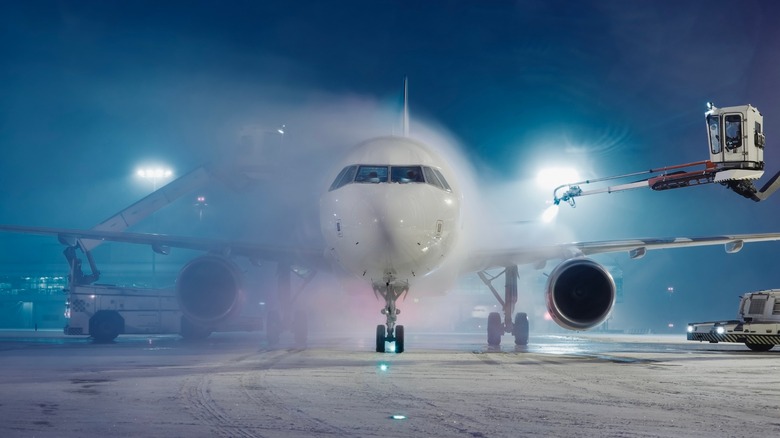
Jaromir Chalabala/Shutterstock
If you look outside during winter days, you might see snow piled up on the ground, buildings, and cars. This white powdery precipitation usually easily moves around — after all, you just need a shovel or a snow blower to clear a path to your vehicle. In fact, you probably just use your hand to remove it from your ride.
But when you fly in winter, you will probably notice that your aircraft was sprayed with some kind of liquid before take-off. Pilots don’t do this because the plane needs a wash before take-off — instead, it’s a crucial process that helps the aircraft and its passengers stay safe during cold-weather conditions.
This process, called de-icing, stops ice from building up on the plane before taking off. But why does ice form on the aircraft in the first place? And why do we pilots need to stop it from happening? As a former pilot, I can explain how a plane flies, what ice does to it, and what ground crews do to stop it from forming.
How an airplane flies
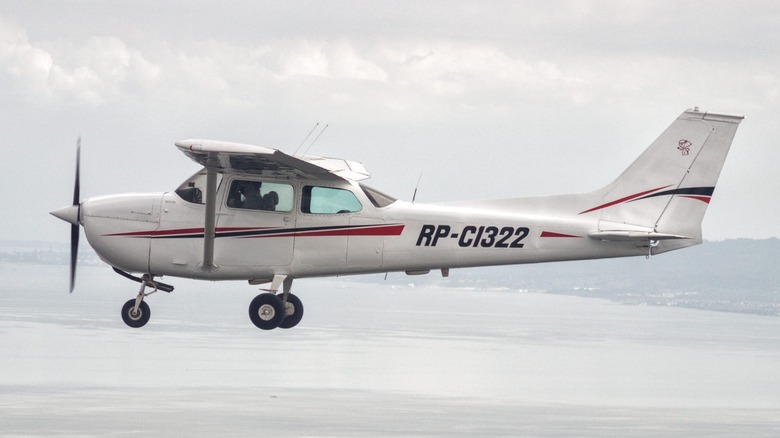
Jowi Morales / SlashGear
In flying school, I’ve been taught the two classical theorems of why airplanes fly. The first school of thought is Bernoulli’s principles — where the shape of the wing increases the speed of the air above it while its flat bottom part causes air to travel slower. The higher airspeed above the wing reduces the air pressure above it, thus sucking the airplane upward and generating lift.
The other school of thought is via Newton’s third law, where air, which has mass, hits the airplane wing and is deflected downward. Then, according to Newton’s third law — where every action is met by an equal and opposite reaction — the aircraft would move upward and have lift.
These two theorems are not exclusive of one another. In fact, new research, as published by Scientific American, suggests that both principles work in tandem to bring an airplane to the sky. But whatever the reason behind lift, one thing is clear — you need a wing where air can flow freely.
If the air flowing around the wing is blocked or disturbed, it could reduce or stop the smooth airflow, thus reducing lift on that particular wing and causing it to stall.
How ice forms on an airplane
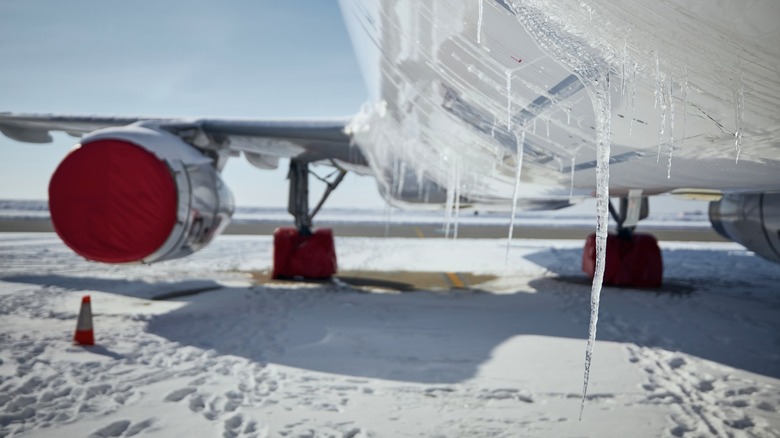
Jaromir Chalabala/Shutterstock
Ice may build up on airplanes when temperatures drop and rain or snow falls on the ground. That’s because aircraft skin is usually much cooler than the surrounding temperature, thus acting like a freezer and turning rainwater or snow into clear ice. This is similar to what you see on cars parked outside after heavy sleet or snowfall.
It’s easy to disregard rain or snow as a danger to aircraft. After all, it usually falls off your car, making it easy to wipe or blow. However, you should remember that airplanes are designed to travel at high speeds. Even if the weather doesn’t seem cold, the air gets significantly colder when an aircraft speeds up due to the wind chill effect. This could quickly turn rainwater or snow into a thin sheet of ice sticking to the plane’s body.
Ice could also form on aircraft even in tropical climates. Although it may not form on the airplane’s body in warmer temperatures, it could happen inside the air intake of propeller planes powered by piston engines. If you fly through clouds, water droplets could go inside your engine. When you combine that with the intake design that speeds up the air going inside it, the temperature could go so low as to freeze the water droplets, blocking it and causing engine failure. That’s why I activate carb heat when I encounter bad weather, which uses the airplane’s exhaust to heat the intake and melt any ice build-up.
What happens to a plane if ice forms on it
Now that we know ice can form on airplanes, how does it affect flight performance? The first thing it could do is to change the airflow around the wings. As I said earlier, air must flow continuously and smoothly to generate lift. If this flow is blocked even by just a thin layer of ice, it will change the wing’s aerodynamic properties and cause it to lose lift. This happened to Air Ontario 1363 when ice and snow on its wings caused it to crash soon after taking off.
Another thing ice can do to aircraft is block crucial ports and sensors. All airplanes, from the fastest military jets and largest commercial airliners to fancy private planes and simple, single-engine trainers, have tubes, ports, and sensors to determine their airspeed, altitude, degree of incline (or angle of attack), and more.
Ice could block these vital sensors and give inaccurate readings, leading to pilots making bad decisions or causing the aircraft’s sensors to respond inappropriately. An example of how this could lead to a disaster is with Air France 447, when ice built up in the Airbus A330’s pitot tubes led to inaccurate airspeed readings, confusing the pilots and leading to its crash in the middle of the Atlantic.
Finally, ice adds weight to aircraft. Even a one cm thick (less than half an inch) ice layer on the wings of the Boeing 737 Max 8 could weigh as much as 275 kg or 607 pounds — about the same as the useful load of the Cessna 152 that I fly. That much weight will affect flight performance, especially if the aircraft is about to depart at the maximum take-off weight or the maximum allowable weight it could carry.
How de-icing prevents ice build-up
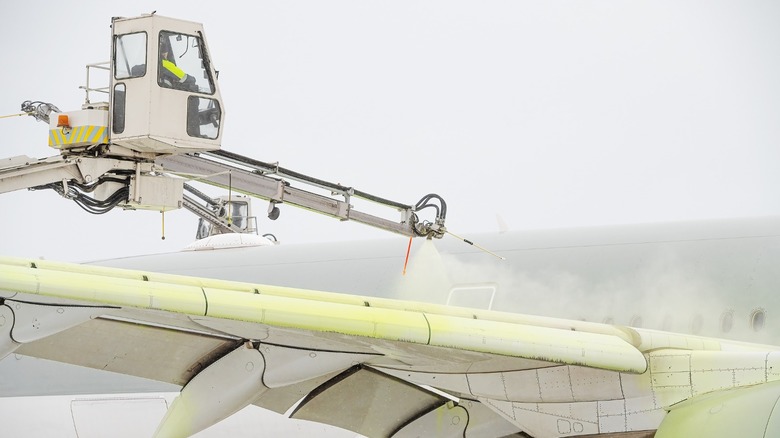
Sergii Chernov/Shutterstock
While researchers have been trying to make ice-repellant materials, none have made it to production so far. So, to prevent ice from forming on airplanes, they must go through de-icing before taking off. This happens to all aircraft — from large airliners to helicopters, military jets, and small propeller planes.
There are usually three places where aircraft are de-iced — it could be either at the plane’s parking spot, on the ramp after it has pushed back from the gate, or at the airport’s designated de-icing pad. It’s then sprayed with de-icing fluid, which stops ice from sticking to the aircraft’s body.
De-icing fluid is also more than just hot water. Rather, it’s a chemical that lowers water’s freezing point, helping prevent ice from forming at the aircraft’s operating temperature. Also, we do not use salt-based de-icers, like the ones used on roads, as they are corrosive and will damage aircraft in the long run.
The different types of de-icing fluid
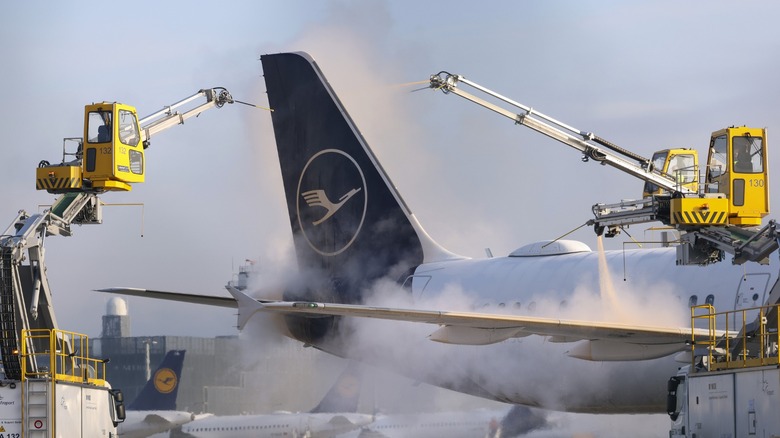
Bloomberg/Getty
Four types of de-icing fluid are used globally: Types I through IV. Type I is the thinnest, only able to protect the aircraft from snow and ice for just six to 11 minutes. If you do not take off in that time, you must reapply it to keep your plane protected. It’s red-orange, helping applicators see which parts of the aircraft where it’s applied.
Type II is a thick, clear or straw-colored, de-icing fluid that protects planes for 20 to 35 minutes. This is usually used in larger airports, where airplanes have longer taxi times before departing. However, aircraft must take off at 100 knots or greater to ensure the de-icing fluid falls off the plane. If not, it could affect the plane’s performance and handling.
Type III is less thick than Type II, thus making it useful for only ten to 20 minutes. However, it only requires a 60-knot take-off speed, making it great for smaller commuter aircraft flying from regional airports. This fluid is colored yellow-green to make it easier to see during application.
Finally, Type IV is the latest iteration of de-icing fluids. It’s emerald-green and about as thick as Type II, requiring the same 100-knot take-off speed. However, it has a longer effectivity time — between 35 and 75 minutes — making it perfect for congested air spaces like New York, where delays could be as long as an hour.
De-icing technology is just one of the many ways that make airline flying the safest method of transportation. While we occasionally hear about deadly air crashes, and the media makes a spectacle out of them, the fact that they happen so rarely is why they’re always big news.